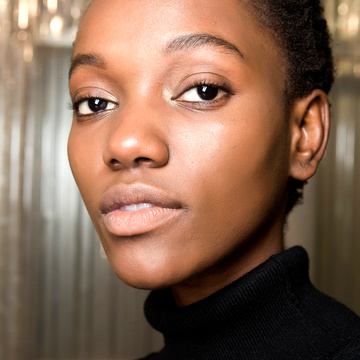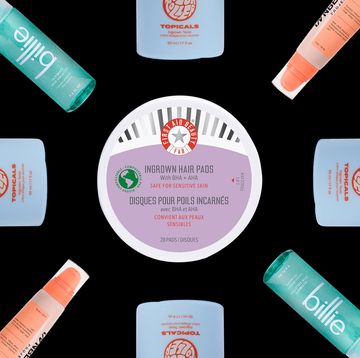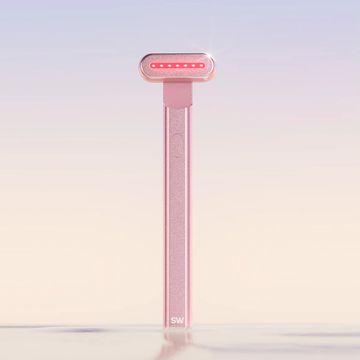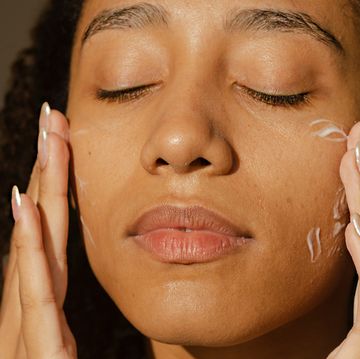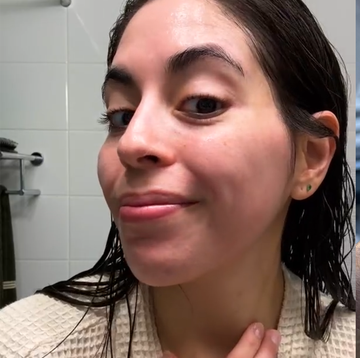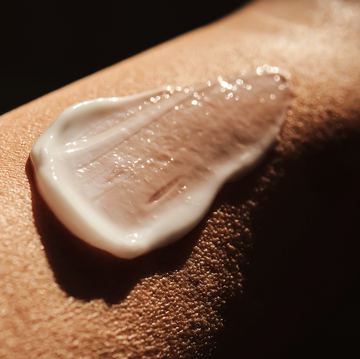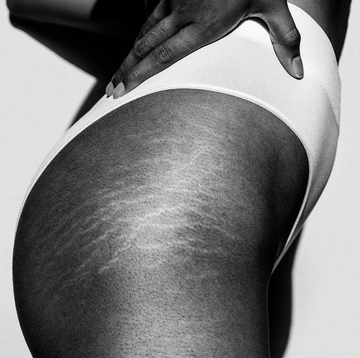Even though Botox and other neurotoxins, like Xeomin, Dysport, Jeuveau, and Daxxify, are super popular these days, there's still a ton of confusion around how they work, what they cost, and what you can expect from a treatment. And since Botox isn't exactly cheap, I decided to create this mini guide—with the help of two injectables experts—that has all the important info to consider before shelling your hard-earned cash on a treatment. It covers everything from how much Botox costs to how long it takes for it to kick in post-injection, along with key aftercare info. So go ahead and start scrolling to find out everything you’ve always wanted to know about Botox.
What is Botox?
Botox, FYI, is the brand name for an FDA-approved drug called botulinum toxin (aka a nerve-blocking drug, more on this below) that temporarily "freezes" muscles in your face to help smooth out frown lines, crow's feet, and forehead lines. It quickly became a household name over the years (think: Kleenex for tissues and Q-tips for cotton swabs). But other popular neuromodulators include Daxxify, Xeomin, Jeuveau, and Dysport.
Botox works by temporarily blocking the nerve signals to your facial muscles, which prevents them from contracting. "By reducing those contractions, the skin above the muscle stays smooth," says plastic surgeon David Shafer, MD. It sounds intense, but rest assured: Botox only works on the little area where it's injected, so it's not like a single injection will shut down the nerve signals in your entire face or body.
How much does Botox cost?
Botox costs vary majorly, but on average, expect to pay $15 to $30 per unit in a big city or $10 to $15 per unit in a rural area. The cost of Botox depends on a few different factors, including where you live, how many units of Botox you're getting (which is how Botox is measured), the area you're injecting in your face (smaller areas obvs cost less), and your provider.
FYI: Injectors price their Botox either by area (so say, the just the forehead or just the eye area as a lump sum), or by unit (this is a measure of quantity—Botox comes in vials that are either 50 or 100 units, and a single injection tends to hold three to five units). The number of Botox units you'll need will depend on your facial anatomy and desired result (more units = a more dramatic smoothing effect, while fewer units = a subtle softening effect).
"I prefer to charge per unit so patients are only paying for what they need," says Dr. Shafer. "If you pay by the area and only want a tiny bit of Botox, it's not really cost-effective." There is an advantage to paying for Botox by area though, and that's consistency. It's always going to cost the same—whether you're getting a teeny bit of Botox or a lot, says Dr. Shafer.
But this also can vary. First of all, it matters which type of botulinum toxin you choose. Xeomin and Dysport tend to be slightly cheaper than Botox brand for similar longevity, while Daxxify can cost as much as double the price of Botox but lasts twice as long (more on that below). It also entirely depends on your provider, as experienced board-certified dermatologists and plastic surgeons generally cost more than a nurse injector at a medspa.
How much does Botox cost for the forehead?
If you pay per area, getting Botox in your forehead will cost $300 on the low end and up to $600+ on the high end. If you pay per unit, the cost will depend on what your provider chargers per unit, so it's not as easy to give a price range, but it can end up being a bit cheaper if you only want/need a bit of Botox. Which is why it's so important to discuss the look you're going for with your provider beforehand.
If you want to completely smooth out wrinkles and reduce movement, you'll need more units. Most people get around 20 to 30 units to relax their forehead, says Dr. Shafer, and often opt to get another 20 to 25 units in their glabella (the area between your eyes that's prone to the frowning "eleven" wrinkles). But "muscle strength will play a factor as to whether a patient might require more than the 20 unit dosage," explains cosmetic physician Rachel Reyes-Beregano, DO. "With that said, it’s important to take into account certain anatomical features of the patient," she notes, explaining that if you have a shorter forehead or hooded eyelids, she might recommend starting with fewer units.
But if you want a light smoothing effect, you might opt for what is often referred to as "baby Botox," which involves injecting smaller amounts of Botox throughout the forehead for a soft look. This, naturally, involves fewer units and can be much less expensive (even as much as half the price as the above).
How much does Botox cost for crow's feet?
How much Botox costs for crow's feet depends on if you pay per units or per area. If it's per area, expect to pay anywhere from $200 to $500 for Botox for crow's feet. As for units? A typical treatment of the crow's feet takes 10 to 25 units on each side (so 20 to 30 total), though your injector may inject less if you still want a lot of movement around your eyes (and, thus, cheaper!).
How long does Botox last for?
Botox lasts anywhere from three to four months, but can last longer depending on how quickly your body metabolizes the toxin, as well as which specific neuromodulator that was used. For example, Daxxify can last from five to six months, while Xeomin only lasts two to three months for some. Most patients return every four months to maintain their results, says Dr. Shafer, who also notes the more you get injected, the longer it will last. "You want to book your next treatment before the previous treatment has worn off, or you will lose the preventive effects of Botox—especially on the improvement of the static wrinkles," Dr. Shafer adds.
For what it's worth, my forehead and eye-area Botox tends to last a full four months (but I also get the max injected), while my friend's Botox (who gets the minimum injected, because she likes a lot of movement in her face) only lasts three months max. Plus, when I got Daxxify in February 2023, I didn't notice movement in my 11s again until September 2023, giving me a smooth forehead for about seven months.
How long does Botox take to work?
Botox takes anywhere from two days to a week to kick in after it's injected. But this length of time entirely depends on the type of toxin—Daxxify softens lines in about two days, while Xeomin and Dysport take three to five days, and Botox can take up to a week. Basically, if you're trying Botox for a big event or special occasion, make sure to book your appointment a week or two in advance, and definitely not the day before.
What are the side effects of Botox?
There are very few side effects to Botox. You may notice a tiny bruise where you were injected, but that'll go away in a day or two. There's also no downtime, meaning your skin will look totally fine after your appointment, other than a few little red marks from where you were injected. You can pretty immediately put on makeup or do your skincare, just avoid intense facial massages for about a week or two afterward (but always make sure to go over these with your provider during your appointment).
That's not to say Botox is totally risk-free, though. One of the more serious potential side effects is droopy eyelids, which can happen if the Botox spreads (often the result of you laying down or napping too soon after getting injected), or if your doctor injects Botox too close to the muscle that raises your eyelid (though experienced doctors will know which area to avoid). Luckily, it's not permanent, and the issue can be treated temporarily with prescription eye drops before resolving on its own after a few weeks.
Does Botox hurt?
Listen, I know that saying Botox feels like a little pinch is a cliche, but it really does feel like a little pinch! If you've ever had a bikini or Brazilian wax, consider Botox a spa day. Many doctors describe getting Botox as a series of sharp, brief pinches—and you can get numbing cream (though honestly, I would say don't waste your time or money). And the whole thing is so quick—my Botox injections take less than two minutes total—so before you can even register that your face is being repeatedly poked with a needle, it's done and over.
Does Botox get rid of all wrinkles?
Botox doesn't get rid of all wrinkles, necessarily. Quick wrinkle lesson: There are actually two types of wrinkles on your body: dynamic wrinkles and static wrinkles.
- Dynamic wrinkles: wrinkles that occur from repetitive movements (think: crow's feet from squinting, smile lines from smiling, or forehead lines from raising your eyebrows).
- Static wrinkles: wrinkles that permanently form as we lose collagen and elastin over time (think: lines around your neck, the folds of your arms, across your cheeks, and around your mouth).
Botox works best on dynamic wrinkles, like the wrinkles around your forehead and eyes, but even static wrinkles that are visible when you're not moving your face will also show significant improvement with Botox, says Dr. Shafer.
Is Botox worth the cost?
IMO, Botox is absolutely worth the cost. It's pricey, yes, but truly effective on everyone, and I can't say that's the case for most beauty treatments in general. I've been getting Botox in my forehead and around my eyes for five years now, and I'm consistently happy with the result—and most people I've talked to who've gotten Botox feel the same, especially if their skin is too sensitive to tolerate strong anti-aging creams and resurfacing lasers.
Overall, any unwanted side effects of Botox are usually not a result of the Botox itself, but the injector, which is another reason to avoid shady spas or suspect Groupon deals. At the end of the day, if the price sounds too good to be true, then it probably is. Remember that you aren't just paying for the product, but also for the experience of the injector, says Dr. Shafer. Like with all things in life, when it comes to Botox, you get what you pay for.
Is Botox covered by insurance?
Unfortunately, no, Botox usually isn't covered by insurance if it's cosmetic. But if you get Botox for sweating, TMJ, migraines, or muscle tension, you might be able to get insurance to pay a portion or all of your neuromodulator costs, so always check with your provider.
Final thoughts:
But if you’re wondering if Botox is worth it, it definitely is all up to personal preference and your budget. FWIW, Cosmo deputy beauty director Lauren Balsamo is one of Botox’s biggest fans (ahem, she’s gotten it over a dozen times in her life so far), swearing by its ability to smooth her forehead. On the other hand, I don’t really rely on the wrinkle-softening effects, but am obsessed with how well it reduces my jaw clenching and tension headaches.
However, you should absolutely make sure that you're working with a provider you trust. Look up before-and-after images, and ask hella questions at your consultation, recommends Dr. Reyes-Beregano. "The right provider will not only have the training and experience but will be able to guide you in what treatment areas are most appropriate for you," she says, as your treatment can be entirely tailored to the look you're going for. Meaning you can entirely avoid the age-old Botox frozen-face memes and feel and look like yourself (just a wrinkle or two less).
Meet the experts:
- David Shafer, MD, is a double board-certified plastic surgeon at Shafer Clinic in New York City, NY. Dr. Shafer specializes in all aspects of aesthetic and cosmetic surgery and combines surgical and noninvasive procedures, like injectables.
- Rachel Reyes-Beregano, DO, is a board-certified physician in Pasadena, CA, with a focus on facial aesthetics, particularly injectables. She's the medical director for SkinSpirit, a medspa with locations across the U.S.
Why trust Cosmopolitan?
Beth Gillette is the beauty editor at Cosmopolitan with more than five years of experience writing and editing skincare stories, like that range from neck-firming creams to the best vitamin C serums. She’s an expert on Botox after testing it on her own fine lines, plus interviewing countless dermatologists, plastic surgeons, and nurse injectors over the years.
Lauren Balsamo is the deputy beauty director at Cosmopolitan with a decade of experience researching, writing, and editing skincare stories that range from the best retinol eye creams to the best pore minimizing treatments. She’s an authority in all skincare categories but an expert when it comes to Botox after having it injected into her forehead over a dozen times.
Beth Gillette is the beauty editor at Cosmopolitan, where she covers skincare, makeup, hair, nails, and more across digital and print. She can generally be found in bright eyeshadow furiously typing her latest feature or hemming and hawing about a new product you "have to try." Prior to Cosmopolitan, she wrote and edited beauty content as an Editor at The Everygirl for four years. Follow her on Instagram for makeup selfies and a new hair 'do every few months.
Lauren Balsamo is deputy beauty director at Cosmopolitan, where she writes, edits, and produces all types of beauty content—from product reviews to personal essays and trend reports. She has covered beauty for nine years at Cosmopolitan and has contributed to Women’s Health and Seventeen magazines as well. Follow her on Instagram.






